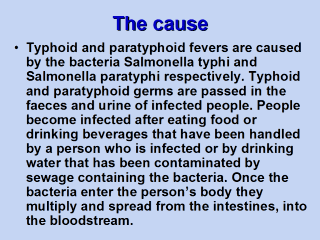 |
Even after recovery
from typhoid or paratyphoid, a small number of individuals (called carriers)
continue to carry the bacteria. These people can be a source of infection
for others. The transmission of typhoid and paratyphoid in
less-industrialized countries may be due to contaminated food or water. In
some countries, shellfish taken from sewage-contaminated beds is an
important route of infection. Where water quality is high, and chlorinated
water piped into the house is widely available, transmission is more likely
to occur via food contaminated by carriers handling food. |
